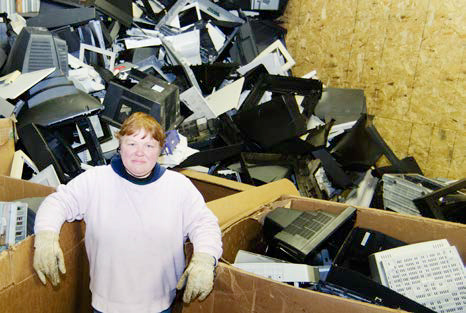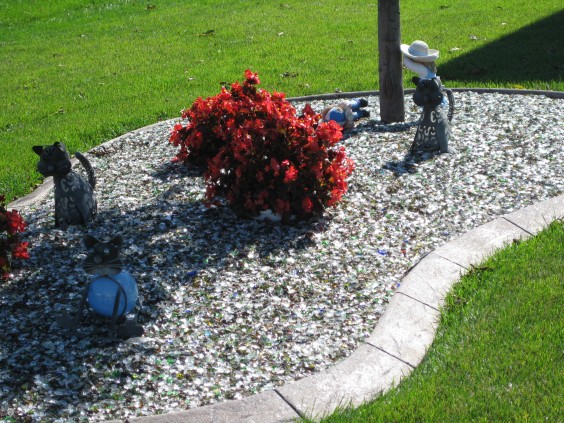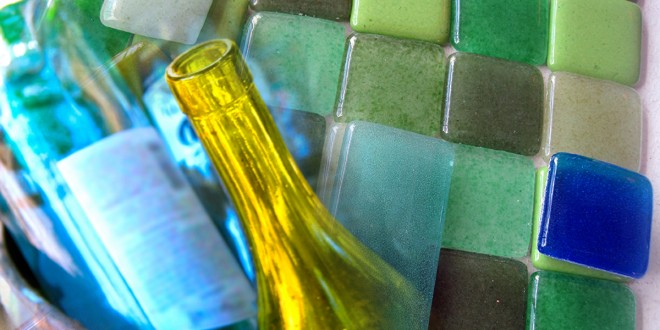Why we don’t recycle glass here, and what it would take to keep it out of the trash.
By Suzy Giovannetone Cope
I grew up in northeastern South Dakota, but when my husband suggested moving back to Aberdeen, I was initially reluctant. I loved California, and one small but not insignificant reason for that was the way the state made it easy to take care of the environment.
I grew up learning about reduce, reuse and recycle, but did not actually put this knowledge into practice until I embraced a simpler way of living on the West Coast. Buy less, find a new purpose for old items, and recycle used-up items or containers instead of sending them to the landfill.
Recycling in California is simple: Store up your tin, aluminum, plastic and glass. Take your goods to the nearest recycling kiosk, not more than a few blocks away. Walk away with a few bucks after the clerk weighs and processes your recyclables.
Our family began the recycling process again after getting settled in Aberdeen. We found a place for cardboard, paper, aluminum, plastic and metals, but we threw our glass in with our garbage, as we did not know of a location that would take it.
By accident, I discovered that the local Target will accept glass recyclables. Put your glass into the correctly marked bin and Target will ship it off to their main distribution center for further processing. But the bin is small—if even a significant segment of Aberdeen’s population tried to recycle there, not to mention people from the surrounding region, the pile would soon overflow into the checkout lanes.
Surely, there had to be other options for glass recycling in the Dakotas. What’s keeping us from recycling our glass? Here is what some people around the region and the nation have to say about the potential for glass recycling here.
Contamination Headaches

Mike Erickson of Dependable Sanitation handles curbside pickup of recyclables for several cities. Photo by Troy McQuillen
Mike Erickson, owner of Dependable Sanitation in Aberdeen, S.D.
Mike Erickson has been recycling for nearly 40 years. He said that his Aberdeen location does not currently accept glass, though their Mitchell, S.D. facility does. The Aberdeen office tried to recycle glass about 15 years ago but chose not to continue.
The last time Dependable Sanitation shipped a truckload of glass to Shakopee, Minn., the entire shipment was rejected because of a few pieces of ceramic material and a tiny makeup jar. This type of glass does not melt at the same temperature as bottle glass.
“It needs to be the right kind of glass and cannot be contaminated,” Erickson said. “Contaminates in glass are plentiful because there are so many different types of glass.”
If you can screw a lid on a glass container, you can recycle it, according to Erickson, but collecting enough glass to ship is time-consuming. The Aberdeen area simply does not generate enough glass to ship often. A lot of manpower is required to collect, load and ship glass when there is a risk of little to no compensation at the end.
Another cause of concern at Dependable Sanitation is worker safety—since handling broken glass puts workers at risk for cuts or eye injuries, Erickson said.
A Break-Even Proposition

Jessica Balek says Renaissance Recycling is passionate about keeping things out of the landfill. Photo by Troy McQuillen
Jessica Balak, Renaissance Recycling in Jamestown, N.D.
Jessica Balak is very passionate about keeping recyclable items out of the landfill, and part of that is accepting glass, which Renaissance has been doing for more than four years. Recycling glass brings in little profit, and requires intense work in crushing, loading, cleaning and refining, but the company thinks the process is worthwhile.
“We pretty much break even with glass, but if it keeps it out of the landfill, we are happy to process it,” Balak said.
Getting started in the glass recycling business is expensive, Balak explained: Finding a supplier willing to purchase the collected glass is the first difficult step, and second is having plenty of storage space to hold the glass until enough has been collected to ship.
“If you ship any less than 45,000 pounds at a time, you will lose money,” Balak said.
To increase the potential profit, the glass must be as refined as possible, but each color of glass must be crushed and stored separately. Workers at Renaissance have to completely sweep and clean the area between each color of glass that is crushed. The process is time-consuming.
Balak does not think safety is an issue for the employees at Renaissance, who takes proper precautions by wearing goggles and gloves. Workers handle the glass material gingerly to avoid the danger of flying broken glass.
The city of Jamestown does not provide curbside pickup for recyclables, so patrons bring all of their materials to the facility and are responsible for sorting them. And Jamestown residents aren’t the only ones: Some regulars travel from Bismarck and Dickenson to recycle their glass at Renaissance, Balak said. She thinks many people may not be aware that glass can be recycled, and the community should do more to inform residents about the benefits of glass recycling.
Heavy and Pricey to Haul

Andrew McCloud thinks it’s important to teach kids about recycling. Photo courtesy South Dakota DENR
Andrew McCloud, an environmental scientist with the South Dakota Department of Environment and Natural Resources Waste Management Program; recycling coordinator for the State of South Dakota
If there was a market for glass in South Dakota and if it were more profitable, there would be increased participation in glass recycling within our state, according to Andrew McCloud. South Dakota has a small population and naturally generates smaller volumes of recyclable glass.
The processing centers that receive glass from local recycling facilities are all located out of state, which increases transportation costs to ship the material. High transportation costs lead to less profit. Overall, glass recycling is not affordable for South Dakota.
“When you have low volume rates and high transportation costs mixed with a low market value, glass recycling in our state can be very challenging,” McCloud said.
McCloud, who is passionate when it comes to educating our children about the importance of recycling, would focus on the things we can recycle. The best thing we can do is to teach children from a young age about what can be recycled or re-purposed, he said: “By practicing reduce, reuse, and recycle in your everyday life, you can create a positive change and environmental impact in our state.”
Crushed Glass with a Purpose

Tumbled glass for landscaping is one of the products Glass Advantage makes. Photo courtesy Glass Advantage
Karen Stearns, Glass Advantage, West Fargo, N.D.
When Glass Advantage started in 2006, only two other companies in the nation did what they do with recycled glass: Produce abrasives for cleaning, and also glass filtration media for household and industrial pools. They also manufacture tumbled glass for landscaping purposes, which can also be put into flooring and countertops.
Today, other similar companies have started up, but it’s still a difficult business. Karen Stearns, who has been with the company for almost seven years, said the company has yet to show a profit.
“The costs are high,” she said. “Electricity, manpower and the maintenance costs are huge. Glass is a hard object and is hard on equipment.”
Also included in the high operation cost is ensuring emission compliance. Other businesses that have moved next to their facility had concern about the emissions from the glass refinery Stearns said. Glass Advantage is now compliant with the emissions created from processing the glass, but the cost to do so was huge.
Glass Advantage ships products to distributors throughout the United States and Canada. One distributor has begun shipping the water filtration media to developing areas of South America for the purpose of providing clean water to remote communities. Not only does glass filtration purify water, but the filtration system is environmentally friendly, uses less material and is more cost-effective in the long run compared to conventional systems, Stearns said.
All of the products manufactured at Glass Advantage are earth friendly, Stearns said: “Glass is inert and does not carry harsh toxins.” Crushed glass grains do not pose a health threat to individuals handling the material she said, and glass water filtration material does not trap bacteria.
Stearns said many Dakotans are not aware that companies such as Glass Advantage exist.
“There is no encouragement to recycle glass,” she said.
Stearns thinks glass recycling would quickly take off if bars and restaurants were required to recycle all of the glass bottles they throw into the garbage. Currently, most of the crushed glass that they receive comes from homeowners, not businesses, from counties in western Minnesota. The facility shares the shipping costs with the counties in order to receive the crushed glass.
Glass Advantage is always willing to connect with recycling professionals to negotiate an agreement to purchase recyclable glass, she said.
From Glass to Art

Nazar evil eye charms are among the artistic items made from recycled glass at Bedrock Industries. Photos courtesy Bedrock Industries
Chris Munford, manager of Bedrock Industries, Seattle, Wash.
According to manager Chris Munford, the employees at Bedrock Industries in Seattle, Wash., are not just there to put another use to glass. They are passionate about building a connection with the community.
Bedrock uses recycled glass to create tile, mosaic glass and a multitude of custom art works. The company began in 1993 when the original owner discovered she could fuse consumer bottle glass and form it into attractive tile.
Bedrock built custom machinery for processing the glass on site. Because of this, they are able to control the raw material flow. Glass can be received in any form and processed down into sand. The goal is to process the glass so it can be used in its natural color: No dyes are used to color any of the glass material at Bedrock.
People bring their bottles, washed with labels removed, to Bedrock and are compensated at 20 cents per pound for their glass items. While other facilities pay to get rid of glass, Bedrock pays to receive it.
Bedrock essentially uses a method of reverse marketing to keep the community involved in the business. Customers and contractors frequently contact the company inquiring about specific types of glass that are accepted. The most commonly used material includes bottle glass, window glass from manufacturers, colored plate glass, art glass from glass blowers and stained glass.
“We can’t use everything, but we are open to seeing what is out there and seeing what we can do with it,” Munford said.
When people bring in their glass, they can stop in the gift shop and see the end products that can be created from it.
The Seattle-based company employs about a dozen people. As a small company, 110 tons of glass is recycled every year. While Bedrock is a for-profit company, they have more of a non-profit feel to their work.
“For us, it feels like a really good thing that we are doing,” Munford said. “The products are good for customers and the environment. We are able to employ people and provide living wages.”
Munford said it might be difficult to replicate their business model in the Dakotas, since it is a niche market and requires enough consumers willing to spend a little more on their products. But Munford said the people they sell to think it’s worth the extra cost.
“The customers like supporting a green product,” he said.
What Can We Do Here?
High maintenance costs, finding ample storage space and high transportation prices are the barriers to recycling glass in the region—but that doesn’t mean keeping glass out of the landfill is impossible.
Today we have opportunities to partner with existing organizations or create our own opportunities to manufacture new products from recycled glass. Even if recycling representatives are reluctant to become involved in the business of glass, there are a few things we can do to keep the material out of the landfill:
- Reuse glass containers repeatedly. Glass can be rinsed and reused for a lifetime. Strive to find new purposes for your jars and containers.
- Challenge local businesses and bottling companies to reuse their own bottles. The idea of sanitizing glass bottles and refilling is commonplace in other countries. It does not hurt to get people thinking about another potential method of reducing glass waste.
We can start with thinking creatively about how to reduce and reuse in our own lives—and if enough of us are thinking that way, maybe we can scale up our thinking to address the needs of the whole region. Who knows? Maybe we could start our own practical-yet-artsy glass recycling companies here in the Dakotas.
Take that, West Coast.
Suzy Giovannettone Cope is a homeschooling mom and freelance writer in Aberdeen, S.D. She volunteers as an advocate for people experiencing homelessness in northeastern South Dakota.
 Dakotafire Get your spark here.
Dakotafire Get your spark here.






